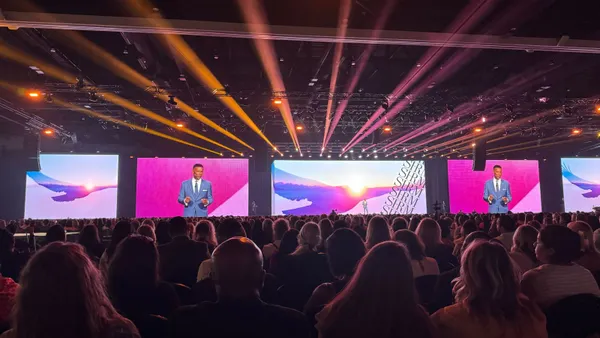Dive Brief:
- Today's offices allow more space for collaborative work activities, according to a new report from architectural and interior design firm Ted Moudis Associates (TMA). The average square footage per seat dedicated to activity-based projects expanded by 18 feet over a two-year period, the firm said in an emailed statement.
- Overall, the trend towards open office spaces continued among TMA clients; 92% of workspaces in the report were classified as "open" workspaces, and 75% of those open workspaces adopted the practice of "benching" (or "desking"), a departure from traditional workstations. Over half (54%) of seats weren't assigned to a particular individual.
- TMA offered several predictions in the report, including that employers will opt for: more semi-enclosed and small focus rooms for one to three occupants; fewer executive suites; more usable square footage per work seat in activity-based workplaces; more space for amenities and wellness activities; and greater emphasis on emotional safety in office design.
Dive Insight:
Overall, the trend in office design has been toward open, less formal workspaces that foster collaboration and face-to-face interaction. General Electric went so far as to make its downtown Cincinnati complex "office-free" in 2016. The company wanted a more home-like environment in which people would like to work, but the company also included smaller areas for meetings requiring more privacy.
However, not all employees welcome open workspaces. Apple employees threatened to quit when the tech giant created a new $5 billion facility, Apple Park, in Silicon Valley. Many preferred closed-in office spaces where they could concentrate on their work in relative quiet. Employees in a separate survey expressed the same dissatisfaction about working in open spaces, which they felt were too distracting. On the whole, however, new offices are moving on from the sea of cubicles that have defined the modern workplace for so long.
In considering design changes or constructing new office space, employers might want to consider the preferences of all workers. Some will like the open spaces that lend themselves to collaborative ways of working, while others will prefer closed-in, more quiet spaces in a private setting. But generally, more employers are pushing for offices that enforce a sense of wellness — more natural light, more walking spaces and a more relaxed vibe overall.











